Ingredient in TOMATO, Mozzarella, Many Complementary Flavors, pages 140-143.
In the Alinea Restaurant cookbook, Mozzarella curd is listed as an ingredient in the component recipe for Mozzarella Balloons in TOMATO, Mozzarella, Many Complementary Flavors. In places like Chicago and New York, I’m sure it’s easy to find — just go to the store and pick some up, eh? Well not so fast, here in San Diego. A coupla chefs I know said, “Oh I can get it.” And there are some local cheese-making classes every once in awhile. But overall, one just can’t easily find it. I even went to Little Italy. I know it’s out there somewhere!
I checked out Tyler Florence’s recipe for Mozarella on The Food Network. What a waste of time. He goes out and buys the curd, then “makes” the cheese by simply kneading the hot curds. That’s not making it!
Online you’ll many Mozzarrella (moat zsa RELL ah) recipes. I found to be extremely helpful Molly Smith’s and Ricki Carroll’s. The recipe below is adapted from several sources including one from La Cucina Italiana magazine, and the results of an afternoon’s trial and error.
It’s not difficult at all, kinda fun, and won’t take much time — once you have the right ingredients.
Basically all the recipes I found were very similar. Some required goat’s milk. Some added extra ingredients for flavor. Others did not. For Mozzarella, start with milk. Unpasteurized works better. Acidify it and warm it up. Then curdle it with rennet. The curds rise to the top of the remaining liquid, or whey. Collect the curds and drain. That’s the Mozzarella curd. To make cheese out of it, melt and knead it like dough to get it all stretchy-cheesy. You can then reheat the whey until its enzymes coagulate, and collect “ricotta” from it.
How to Make Fresh Mozzarella Curd
First I dissolved the citric acid in half a cup of warm water, and separately, dissolved the liquid rennet in three-quarters of a cup of warm water. It’s important to use non-chlorinated water. I used bottled.
What is rennet?
Rennet is used to curdle milk, making its proteins combine, thus separating the curds from the whey. Animal rennet is an enzyme from the stomach of a young milk-fed calf, lamb or goat. Vegetable rennet is extracted from a mold (and is considered vegetarian). Artificial rennets such as Chymostar are microbial GMO rennets with a chymosin-producing gene from the calf. They’re less expensive and used commercially in cheesemaking.Source: New England Cheesemaking Supply
I put a gallon of raw whole milk in the stockpot and added the citric acid mixture. Then slowly brought up the heat, stirring, until it reached 88ºF. Kept it at that temp for an hour. If it goes beyond 91ºF, take it off the heat until it comes back down. The milk will begin to lump up, or curdle.
After an hour, I slowly added the rennet mixture, and stirred gently. Just long enough to mix it completely into the milk. Then let it sit, covered, for about 15 minutes.
This is the point where it’s supposed to curdle into a large layer of curds on top of the remaining yellow liquid, or whey.
If it does, cut it up into squares with a kitchen knife. Mine didn’t. It was curdled but not solid, so I did not have to cut it up. I found out that this happens when it’s too acidic. Less citric acid next time…
Keeping the temperature at 88ºF, I turned the curds over every 10 minutes for 30 minutes. Then let stand undisturbed for another 30 minutes. They were ready now.
I skimmed out the curds and placed into a strainer lined with cheesecloth. (Hey, there’s a novel idea — I’m actually using this stuff for what it was made for!) Don’t throw out your whey! You can make Ricotta.
I tied up the cheesecloth into a bag with some kitchen string, hung it up, and let it drain for several hours.
Now that’s the curd. To make it cheese, you drop a blob of it in hot water to melt it a bit. Then remove and work it, kneading and stretching it.
Making Fresh Ricotta Cheese
In Italian, Ricotta (ree COHT ta) means “twice cooked.” And that’s really all it is, twice cooked milk/whey. While the Mozzarella drained, I brought the pot of remaining whey to a simmer for about 10 minutes. The albumin proteins in the whey coagulate, and appear as little grains in the liquid.
You can pour this into a sieve lined with several layers of cheesecloth, or fine butter muslin, or a coffee filter. Use something really fine to capture the ricotta particles. I used a cloth napkin. I also read in this recipe you can add a bit of vinegar to help it along.
I let it drain for about 30 minutes, then had a bit of fresh Ricotta!
Next, I’m going to make Mozzarella balloons. And that’s a whole ‘nother story!
Ingredients
1.75 teaspoons citric acid, from L’Epicerie
1 gallon raw whole milk, from Whole Foods
0.5 teaspoon Malaka liquid vegetable rennet, from Whole Foods
Arrowhead bottled water
Equipment
Salter digital scale
Measuring spoons and bowls
Large stock pot
Digital thermometer
Spoon
Wire whisk
Cheesecloth
Kitchen string
Sieve
Stainless bowl
Yields: about 12 ounces Mozzarella and 1 ounce of Ricotta.
Next, TOMATO, Mozzarella, Many Complementary Flavors

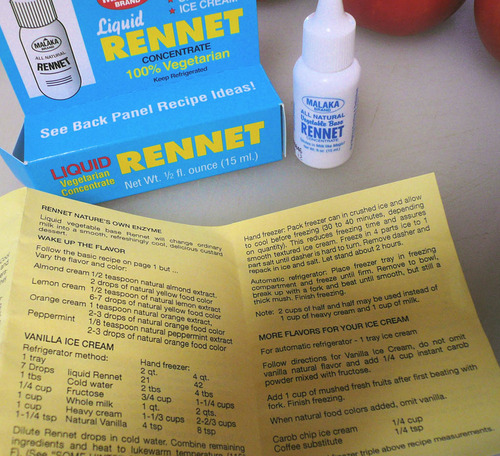
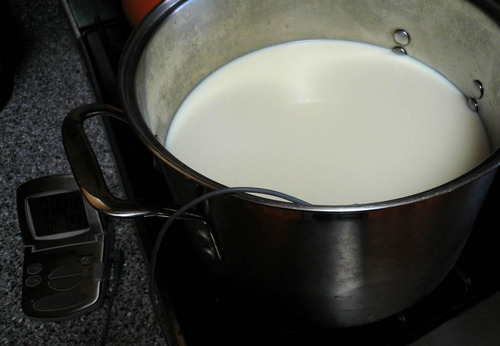

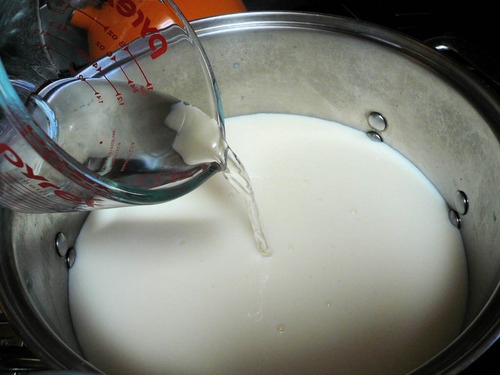
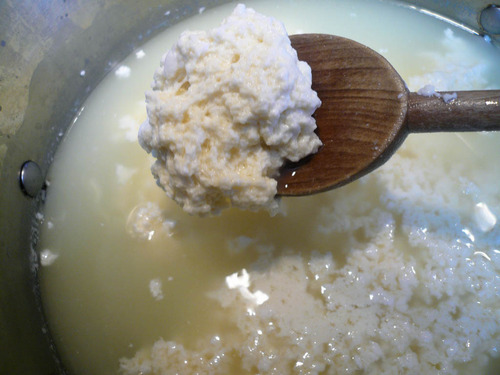
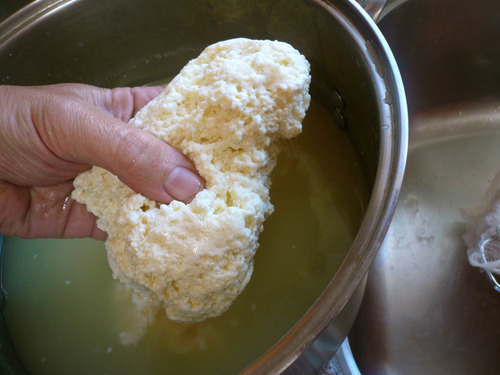
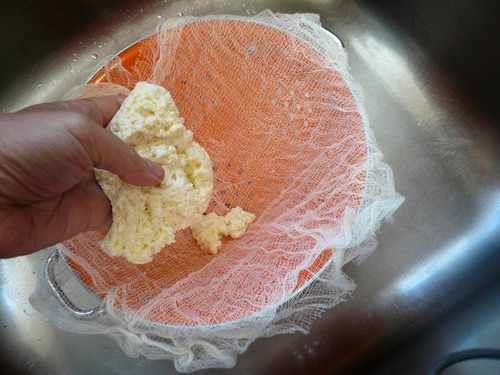

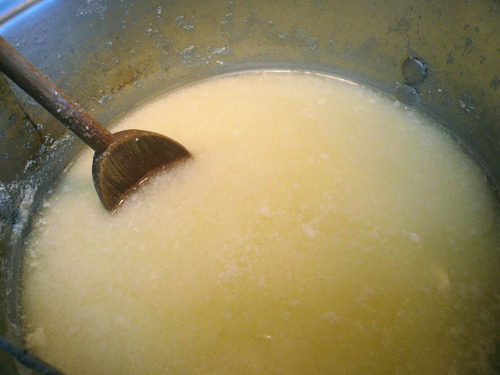
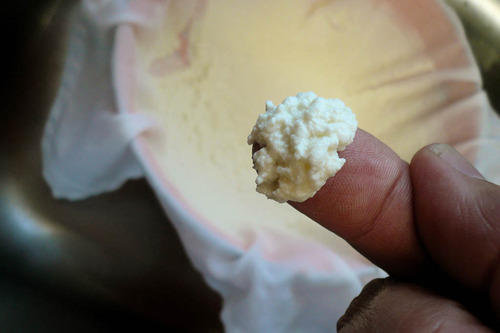
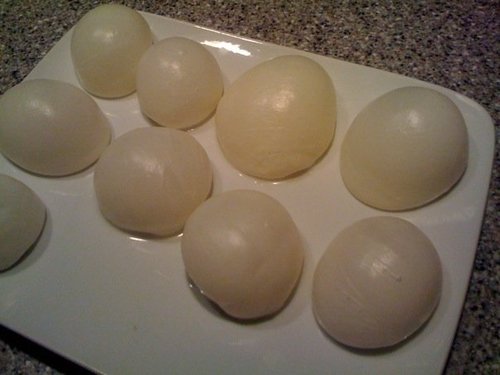
8 Responses to Mozzarella Curd